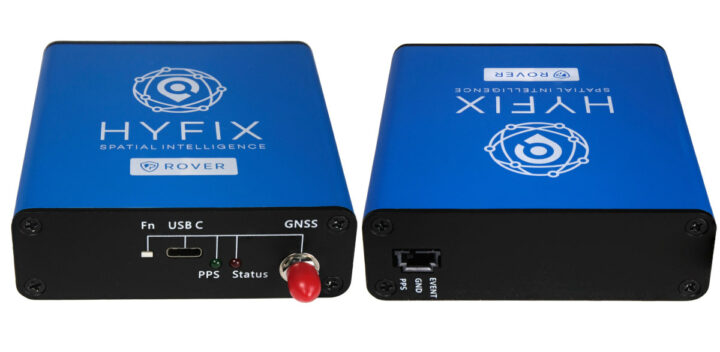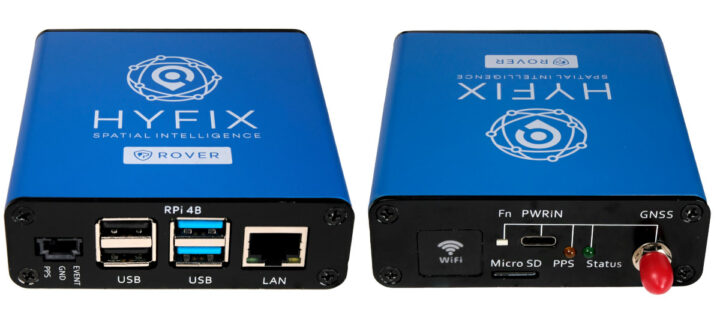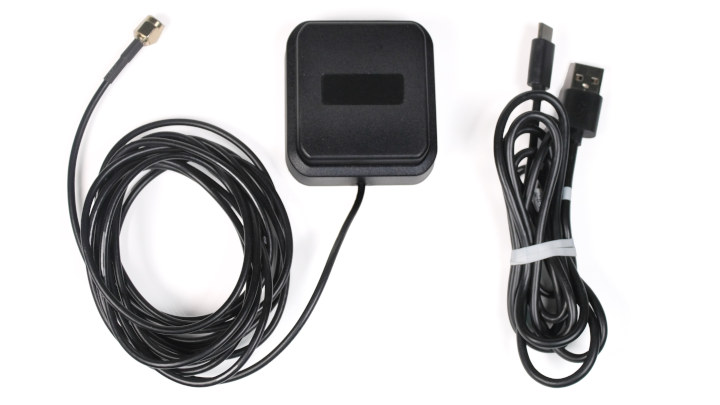HYFIX’s RTK Rover is an affordable, centimeter-accurate RTK (Real-time Kinematic) GNSS receiver with either a USB interface or/and Ethernet connectivity with the latter relying on a Raspberry Pi 4 SBC.
As a reminder, RTK relies on traditional GNSS networks like GPS and works with a Base station at a fixed location and a Rover station that can be fitted to a drone or mobile robot in order to determine the position with up to one-centimeter accuracy. The RTK Rover from HYFIX is equipped with a dual-band LC29H GNSS module from Quectel and an onboard IMU sensor that tracks position through dead reckoning when GNSS connectivity is lost.

RTK Rover specifications:
- MiniPCIe card with Dual-Band L1/L5 RTK Receiver (Quectel LC29H)
- Antenna – External antenna (6x5x2 cm) connected to SMA connector
- Sensor – IMU
- Interfaces
- USB Type-C port for power and serial Interface
- Ethernet Rover Kit only – Gigabit Ethernet and USB ports via Raspberry Pi 4 SBC
- Misc – Fn (Function) button, PPS and Status LEDs, 3-pin connector with PPS, GND, and EVENT
- Power Supply – 5V via USB-C port
- Dimensions – 10 x 9 x 3 cm (metal enclosure)

Both versions have open-source board designs in the sense PDF schematics, mechanical files, and drivers are provided on GitHub, and they work with QGNSS software, RTKLib, and HYFIX open-source tools, but I could not find a link for the latter, so maybe they’ll be added to GitHub soon.
The device comes with a 30-day trial for the GEODNET decentralized GNSS reference network that allows you to get accurate location data without your own base station(s) and can be used for applications such as civil surveying, high-definition mapping, smart agriculture, and robotic solutions. We covered the GEODNET network earlier this year when writing about the ROCK Base triple-frequency RTK/GNSS base station. The GEOD token is associated with the network and the coverage map now shows close to 3,300 miners spread across the world.

HYFIX has launched their RTK Rover on Crowd Supply with a symbolic $1 funding goal. The USB version requires a $195 pledge, while the Ethernet model goes for $395. Shipping adds $8 to the US, and $18 to the rest of the world. Deliveries are scheduled to start at the end of November 2023. A few more details may also be found on the HYFIX website.

Jean-Luc started CNX Software in 2010 as a part-time endeavor, before quitting his job as a software engineering manager, and starting to write daily news, and reviews full time later in 2011.
Support CNX Software! Donate via cryptocurrencies, become a Patron on Patreon, or purchase goods on Amazon or Aliexpress. We also use affiliate links in articles to earn commissions if you make a purchase after clicking on those links.





Its wat you call afforible i guess, you can get a lot cheaper usb GNSS devices.
The keyword is RTK here.
I don’t know anything about this stuff.. but seems kinda big to put on a drone, no?
I wonder how expensive the base station would be – or they’re pretty much expecting people to use the GEODNET subscription service?
It depends on the drone. This type of drone should be fine for example:
https://www.cnx-software.com/wp-content/uploads/2023/07/960d33c6-026e-4c6b-bf7c-00549286c366.jpeg
The ROCK Base station mentioned in the post sells for $750.
Hey,
I live in Brazil and I’m looking for a solution to apply to a semi autonomous CAT heavy machine and other industrial applications. Could you be more specific about the protocols (NMEA, GSOF, RTCM) I can have on the Eth interfaces? Is there a user interface for configuring static IP? Can I use PoE as a power supply? There is a possibility to use a base RTK and a repeater to spread the signal in a building?
You’d better ask on Crowd Supply. I forgot to include the link when I published it, but it’s now there at the end of the article.
Not a lot of info about Quectel LC29H on the internets, but I supose this indicates that it works just fine under linux?
I can see Quectel only offers Android drivers, but since it works with a Raspberry Pi, it should mean Linux is fine.
ok, but nothing on their github repo so the question is how do you actuall run that under linux 🙂
“The master can read from and write to the modules via the I2C bus.” so I2c protocol, but probably would have to do everything from scratch
And Quectel also has this EVB which “Supports standard NMEA message, RTCM message, binary data, PAIR/PQTM message and firmware upgrade.”
I see some kind of development board with the chip for 90€ which would be great for testing, just don’t want to go very low level and would prefer something working. But probably let’s wait